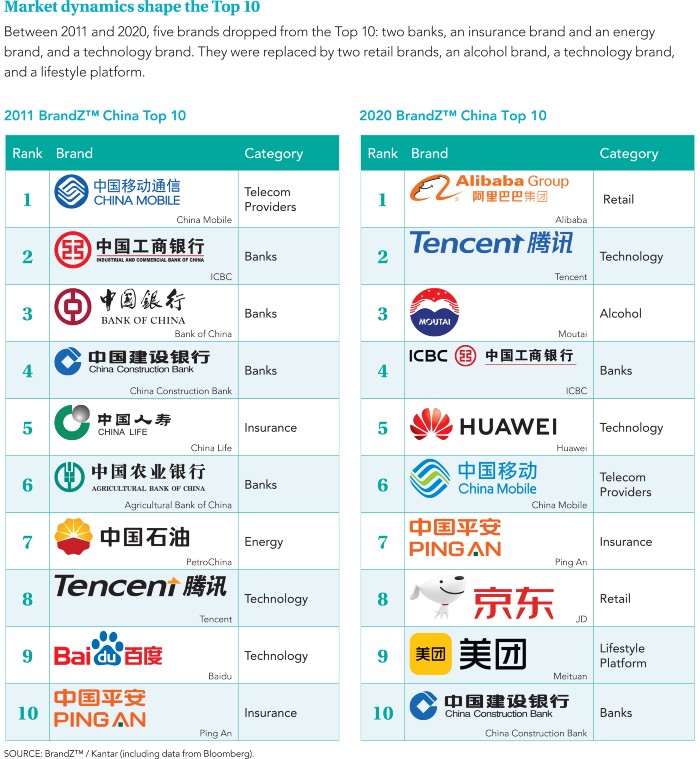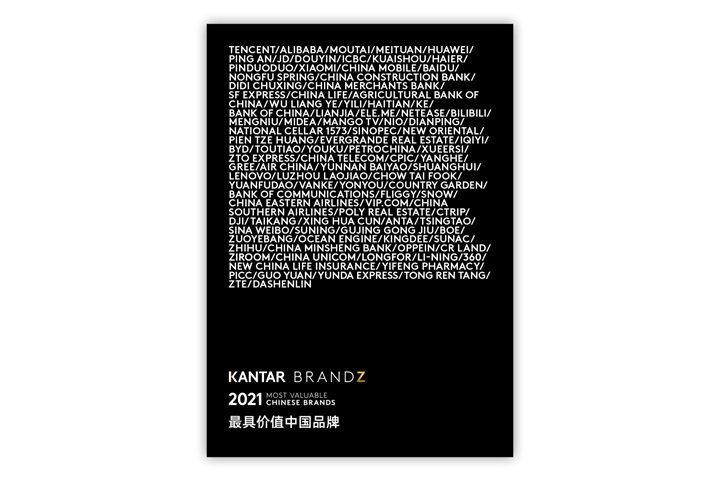In a year of exceptional pressure on growth, the BrandZ™ Top 100 Most Valuable Chinese Brands gained 12% in value, in the 10th edition of the ranking revealed today by WPP and Kantar. The Top 100 brands increased their worth by $106.8 billion to reach $996.4 billion, demonstrating the resilience of strong brands and their ability to build and sustain value in the most difficult of years.
Alibaba remains China’s most valuable brand for the second year, growing +9% to $153.3 billion, while Tencent (no.2) rose +9% to $151.0 billion. Premium alcohol brand Moutai (+47%; $53.8 billion) has climbed two places to no.3. Alibaba reinforced its leading position with a strategy that focussed on lower tier and overseas markets, acquiring NetEase Kaola to meet demand for cross-border retail, and expanding its Freshippo retail and distribution locations. It also linked consumer data and logistics capabilities more closely to better recognise and fulfil customers’ needs.
Fourteen of the 24 categories grew in value, with Technology contributing a quarter of the ranking’s total value and Retail around a fifth. Entertainment saw the highest growth for the second year running, rising 221% in value as people spent more time online in lockdown, while Education grew by 92% as the increasing popularity of online learning was further stimulated by COVID-19.
Each of the Top 10 Risers (the brands which increased most in value year-on-year) grew by over 50%, with education provider Xueersi (no.38, +120% $4.6 billion) and alcohol brand Wu Liang Ye (no.26, +116%, $8.0 billion) more than doubling in value. Three are education brands, with Xueersi joined by New Oriental (no.36; +78%, $4.9 billion) and VIPKID (no.84; +67%, $1.3 billion). Third highest riser Lufax (no.19; +80%, $12.4 billion), a newcomer to the ranking in 2019 which was formed by financial services giant Ping An, grew +80% after successfully broadening its consumer finance operation.
Growth within the China Top 100 has been driven by the ability of the most valuable brands to align with the major trends shaping the Chinese market, including the desire for self-improvement and wellness, rapid urbanisation, premiumisation, and heightened national pride. Many trends were accelerated by COVID-19 as consumers reconsidered their priorities, with the accumulation of wealth declining in importance, and an increased focus on health, the environment, and the welfare of the nation.
There are 16 newcomers this year, led by short-form video brand Douyin (no.14; $16.9 billion) and e-commerce group buying platform Pinduoduo (no.23; $9.5 billion). Among the new entries are five unicorns (start-up companies valued at over $1 billion): Douyin and video sharing app Kuaishou (no.25; $8.6 billion), real estate agent Ziroom (no.71; $2.1 billion), and tech brands Toutiao (no.67; $2.3 billion) and Zhihu (no.91; $1.0 billion). Athleisure brand Li-Ning (no.99; $848 million) re-entered the ranking for the first time since 2013, after capitalising on the rise in patriotism with a range that celebrated Chinese culture and design.
Chinese brands continue to pursue global growth and rapidly expand their international presence and stature. Only one was listed in the 2006 ranking of the most valuable global brands; the 2020 ranking includes 17.
The 2020 Top 10 BrandZ™ China Top 100 Most Valuable Chinese Brands

Compared with brands in other markets the BrandZ China Top 100 score highly in two key measures of brand equity, which drives value growth: Power, the consumer disposition to choose a brand over the competition, and Premium, the disposition to pay a higher price. However, Chinese brands lag global brands in another key component, Difference, which means they have an opportunity to drive further value growth by strengthening the perception that they stand out from the competition.
During the 10 years since BrandZ first valued China’s brands, the brand landscape has radically transformed as the economy rebalanced from production to consumption, while Chinese consumers have become the most sophisticated on the planet. Only 5 brands that were in the Top 10 when the rankings started still remain there today. This year, within just a few months, we’ve seen COVID-19 have a massive impact on the way consumers shop, what they buy, and their relationship with brands. Through all of these changes, the successful brands are those that have embraced digital, kept pace with consumer preferences and the way they navigate their lives.
It has never been more critical for brands to respond to shifting consumer priorities. For example, alongside delivering superior products and services, they need to demonstrate that they care for their employees and customers, the environment and society as a whole. COVID-19 will continue to influence consumer values, attitudes and behaviours, and this will impact needs, desires, brand selection and purchasing. Understanding Chinese consumers today, in all their diversity, depends on having deep human-centred insights. Brands must then act on those insights, making bold changes where necessary.
10 years of BrandZ China Brand Valuations: A decade of radical transformation
Analysis of BrandZ’s 10 years of data on Chinese brands highlights their success on the world stage: during that time China’s Top 50 has grown 225% in value, outpacing the Global Top 50, which grew 126%. Over the same period, a stock portfolio made up of the brands in the BrandZ China ranking grew at more than three times the rate of the MSCI China Index.
The research and insights have been distilled into 10 Brand Building Lessons from 10 Years of BrandZ™ Analysis, which can be read in full in the BrandZ China Top 100 report. These include higher-order needs motivate consumers; creativity is essential to build brand value; quality-of-life aspirations drive premiumisation; technology advances enable greater personalization, and Chinese brand builders pursue global growth – as well as:
Brand building begins with a clear purpose
China’s most valuable brands score higher than the average on BrandZ measures of purpose, which has escalated in importance during the pandemic. Tencent shifted from emphasising connectivity to advancing ‘Value for users, tech for good’, while Alibaba focused on helping small businesses to flourish. Pinduoduo enabled local businesses and farmers to sell their products and services in upper tier markets, and Kuaishou supplied e-commerce capability and tools to help low income Chinese develop as online entrepreneurs.
Rapid change makes innovation vital
Value growth for the brands that score highly on the BrandZ Innovation Index is almost nine times greater than those that score low. Haier (no.12; $18.7 billion) has successfully transformed into a leading Internet of Things (IoT) ecosystem brand, the advantages of which include the delivery of a seamless experience, an ecosystem that is boundless, and the ability to offer auto-sensing payments. Owing to continuous collaborative innovation among Haier, its users and its partners, the brand achieves constant improvement and evolution.
Brand growth potential expands in lower tiers
The rapid development of smaller cities has created new opportunities. Kuaishou has become a lower tier version of Douyin, while online classified ad marketplace 58.com (no.75; $1.7 billion) launched 58 Town to serve lower tier communities. Pinduoduo, which began by serving lower tier consumers, has achieved national prominence as a rival to Alibaba and JD.
China has leapfrogged in customer experience
Experience is a critical differentiator, now consumers can get what they want whenever they want it. The brands that score highest on ‘positive experience’ grew the brand value over three times faster year-on-year. Examples include JD, which opened its largest physical store, JD E-Space, an experiential centre where consumers can test and purchase products.
Ecosystems engage users with content to drive sales
Content commerce is an example of the trend towards experiences that increase convenience by being multifunctional or overlapping. Brands are integrating social media and e-commerce in a way that simplifies people’s lives – creating appealing content that can be seamlessly monetised. For instance, short-video sharing apps like Douyin often provide opportunities to purchase items for rapid delivery.


